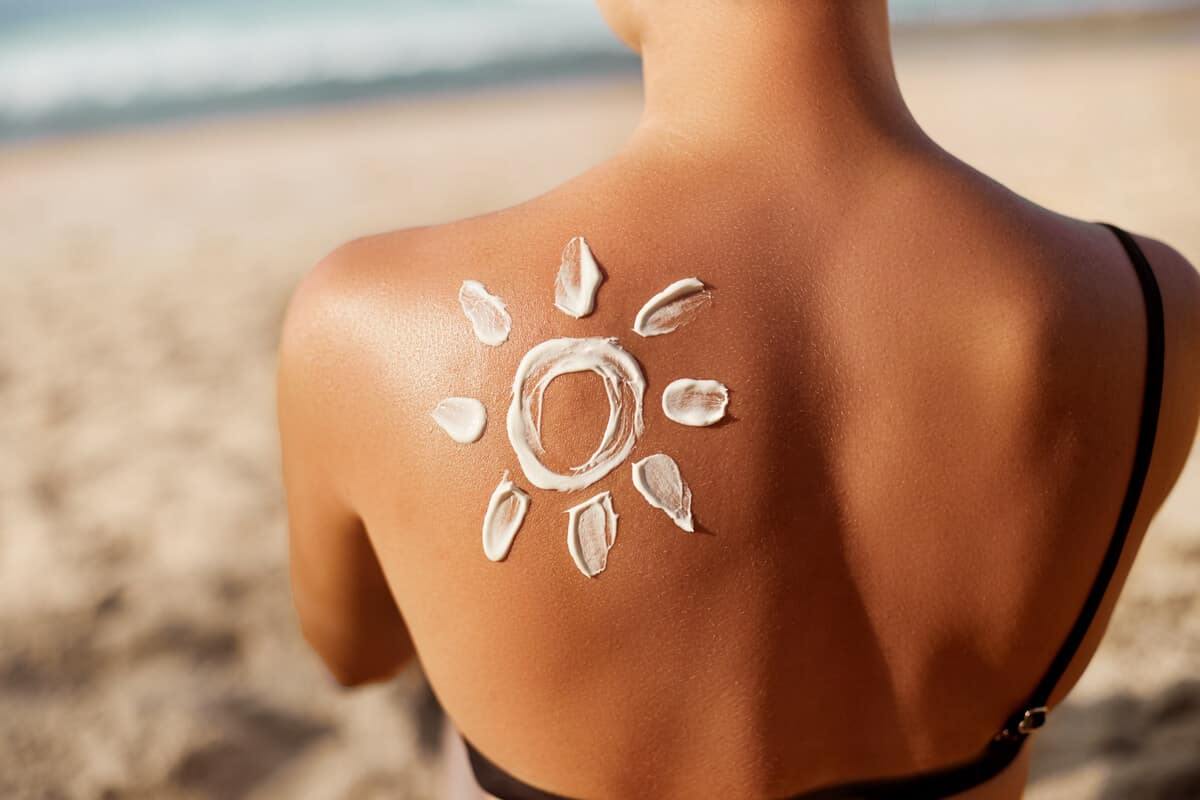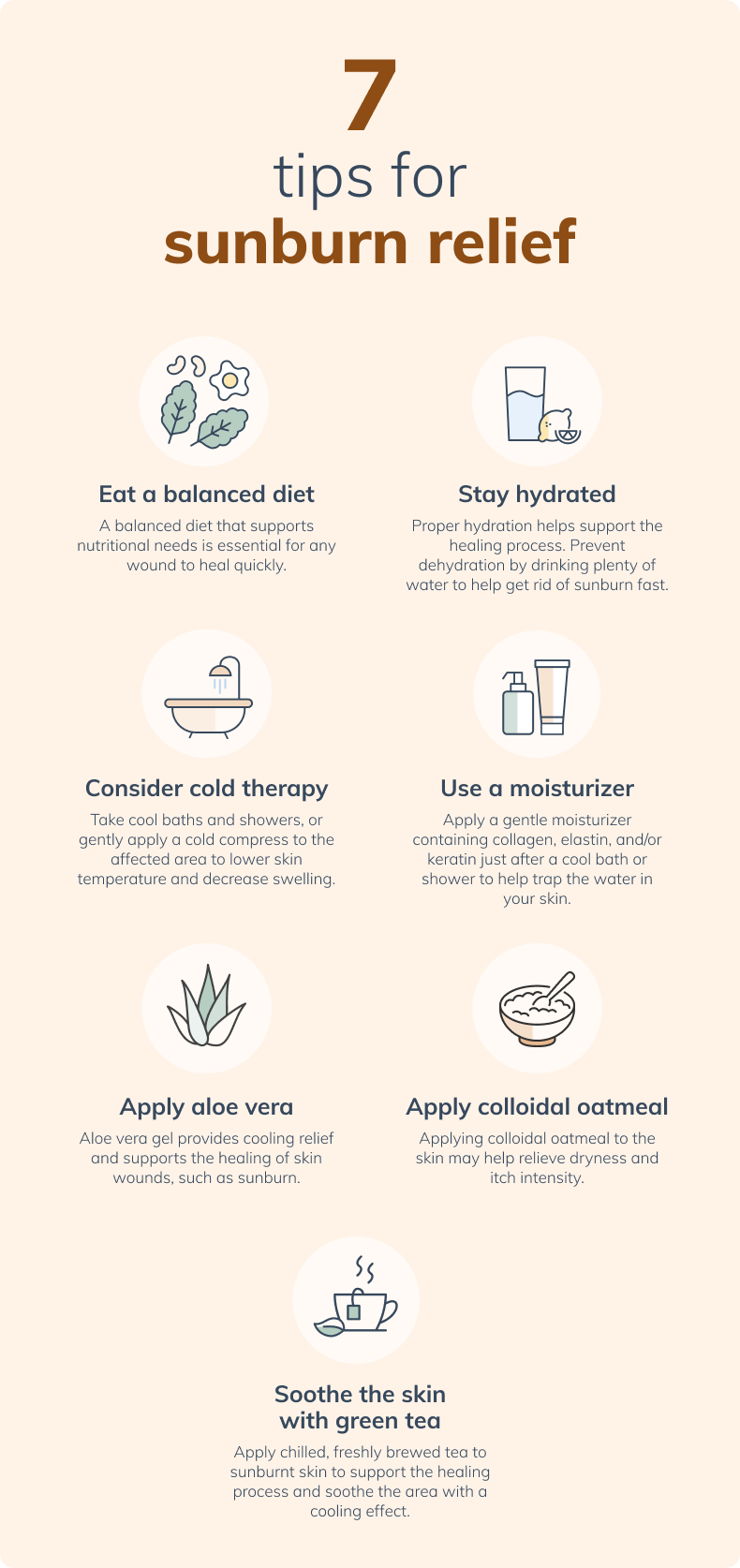Symptoms of sunburn
Symptoms of sunburn occur gradually, within about four to 36 hours after sun exposure. (4) The earliest sign of sunburn is flushed skin that may be tender or hot. (26) Other symptoms may include:- Blistering
- Fatigue
- Fever
- Headache
- Nausea
- Peeling
- Red, dry, painful eyes
- Swelling (4)

Blistering sunburn indicates a deeper, second-degree burn. (1)
What causes sunburn?
Melanin is a complex molecule that is responsible for our skin and hair pigmentation and protects our skin and eyes from UV radiation. (24) When UV rays contact the outer layer of our skin, melanin-producing cells (melanocytes) rapidly produce melanin for protection, causing us to darken or tan. (17) Too much exposure to UV rays can damage melanin, leading to deeper skin damage and sunburn. (17)
UV rays are strongest between 10 a.m. and 2 p.m. (16)
Lasting effects of sunburn
Overexposure to the sun can lead to long-term damage to melanocytes and collagen fibers, which support the skin’s strength and elasticity. (18) This damage accelerates skin aging, contributing to age spots, premature wrinkling, and an increased risk of certain skin cancers. (4)Nonmelanoma skin cancer
Nonmelanoma skin cancer, also referred to as keratinocyte carcinoma, is the most common form of cancer in humans. (25) Reports indicate that UV exposure is associated with 90% of nonmelanoma skin cancer cases, including cases of basal cell carcinoma (BCC) and squamous cell carcinoma (SCC). (29) When diagnosed early, BCC and SCC can typically be treated and cured; however, the risk for recurrent carcinoma is increased. (29) A personal history of nonmelanoma skin cancer has also been associated with an elevated risk of malignant melanoma (MM), a less common but more harmful skin cancer.Malignant melanoma skin cancer
Though MM only accounts for 4% of skin cancer cases, it is responsible for 80% of skin-cancer related deaths. (12) Genetic factors and sunburn are among the few known causes of MM, with sun exposure being implicated in 65% of cases. (12)(29) Contrary to nonmelanoma skin cancers, there is less evidence implicating the effect of cumulative sun exposure on MM. (6) Research indicates that intermittent (periodic) sun exposure is more likely to trigger MM than regular sun exposure. (20) Intermittent sun exposure typically occurs during outdoor recreational activities or vacation activities, which are also associated with sunburn. (6)Did you know? Chronic sun damage to the eyes may contribute to the development of cataracts and macular degeneration, conditions that can lead to blindness. (4)
Preventing sunburn
Sun exposure is a part of a healthy lifestyle and can be protective if sunburn is avoided. Limited vitamin D is acquired through dietary sources, such as fatty fish, and is mainly synthesized when sunlight comes in contact with our skin. (6) Vitamin D deficiency affects about 50% of the population worldwide, and studies indicate that sun-sensitive individuals tend to have suboptimal vitamin D levels. (6)(14) Vitamin D has significant anti-inflammatory effects that may help reduce the risk of sunburn as well as certain cancers, including MM. (3)(6)(14) Next time you’re outdoors, try to prevent sunburn with the following tips:- Apply a broad-spectrum sunscreen with a sun protection factor (SPF) of 15 or greater and reapply every two hours.
- Wear sun-protective clothing (e.g., wide-brimmed hat, tightly-woven cotton fabrics).
- Wear wrap-around sunglasses with UV protection.
- Stay in the shade, such as under an umbrella or tree, whenever possible. (5)
7 natural remedies for sunburn relief
Healing sunburn takes time, about three to five days for mild cases. (4) The best thing for sunburn during this time is to:- Avoid spending time in the sun.
- Refrain from itching or popping blisters to reduce the risk of infection.
- Resist touching peeling skin and allow it to detach on its own. (28)

Follow these tips for sunburn relief.
1. Nutrient-dense diet
A balanced diet that supports nutritional needs is essential for any wound to heal quickly. (23) Glucose (sugar) from carbohydrates supports tissue formation, fatty acids play a key role in the inflammatory process, and protein supports healing efficiency and collagen formation. (23) In addition to key nutrients, whole foods, such as fruits and vegetables, are rich in cell-protective antioxidants. These compounds have been found to exhibit anticancer and anti-inflammatory properties. (11)(27)2. Hydration
Hydration is also important to support the healing process. (1) Spending time in the sun and having sunburn increases the risk for dehydration. (1) When burned, the release of certain inflammatory molecules triggers the porous capillaries (small blood vessels) to increase fluid flow. (8) This leads to edema, a state of swelling that is caused by interstitial fluid accumulation. (15) Prevent dehydration by drinking plenty of water to help get rid of sunburn fast.
The color of your urine can provide an indication of your hydration level.
3. Cold therapy
Take cool baths and showers, or gently apply a cold compress to the affected area. This cold therapy lowers skin temperature and decreases swelling and nerve activity to reduce pain. (9)4. Moisturizer
To support skin hydration, apply a gentle moisturizer just after a cool bath or shower to help trap the water in your skin. (1) Moisturizer application fills spaces between partially peeling skin flakes and creates a soothing protective barrier that promotes better water absorption and retention. (21)Did you know? The best moisturizers for sun damaged skin are ones that contain collagen, elastin, and/or keratin. (21)
5. Aloe vera
Aloe vera gel provides cooling relief and supports the healing of skin wounds, such as sunburn. (10) Experimental research indicates that applying aloe vera to sunburn moisturizes the area, supports collagen formation, and has protective anti-inflammatory and antimicrobial properties. (10)(13) Aloe vera gel or gentle moisturizers containing aloe vera may help soothe hot, painful sunburn.6. Colloidal oatmeal
Finely ground oats (Avena sativa), referred to as colloidal oatmeal, offer anti-inflammatory and antioxidant properties when applied to the skin. (22) Applying colloidal oatmeal can significantly relieve skin dryness and itch intensity. (22) Colloidal oatmeal can be incorporated into bathwater, soaps, and moisturizers, and the U.S. Food and Drug Administration (FDA) categorizes colloidal oatmeal products as skin protectants. (22)7. Green tea
Applying chilled, freshly brewed tea to sunburnt skin may support the healing process and soothe the area with a cooling effect. (10) Green tea contains polyphenols, an antioxidant compound that has been shown to exert anti-inflammatory skin protective effects. (10) In animal studies, topical application of green tea polyphenols was found to reduce skin damage and redness. (10)Addressing severe sunburn
Most cases of mild sunburn will heal on their own; however, more severe cases of sunburn may require further intervention. Check with your integrative practitioner if you experience any of the following:- Dehydration
- Extensive blistering and pain
- Headache
- High fever (>101˚F, 38˚C)
- Nausea and vomiting
- Severe sunburn that covers more than 15% of the body (4)(28)
The bottom line
Although sunburn may seem temporary, it can cause long-lasting skin damage that increases the risk of skin cancer. Sunburn prevention is best; however, if sunburn does occur, natural sunburn relief remedies can be used to soothe symptoms and support the healing process. If sunburn is severe, be sure to consult with your practitioner as soon as possible.- American Academy of Dermatology Association. (2014). How to treat sunburn. https://www.aad.org/public/everyday-care/injured-skin/burns/treat-sunburn
- Arizona Department of Health Services. (n.d.). How long does it take to get a sunburn? https://www.azdhs.gov/documents/prevention/nutrition-physical-activity/empower/resources-policies/sunburn-card.pdf
- Bikle, D. D. (2017). Vitamin D prevents sunburn: Tips for the summer? The Journal of Investigative Dermatology, 137(10), 2045–2047.
- Centers for Disease Control and Prevention. (2018). Sun exposure – sunburn. https://www.cdc.gov/niosh/outdoor-workers/about/sun-exposure.html
- Centers for Disease Control and Prevention. (2021). Sun Safety. https://www.cdc.gov/skin-cancer/sun-safety/index.html
- Field, S., Davies, J., Bishop, D. T., & Newton-Bishop, J. A. (2013). Vitamin D and melanoma. Dermato-Endocrinology, 5(1), 121–129.
- Guerra, K. C., Urban, K., & Crane, J. S. (2021). Sunburn. In StatPearls. StatPearls Publishing.
- Haberal, M., Sakallioglu Abali, A. E., & Karakayali, H. (2010). Fluid management in major burn injuries. Indian Journal of Plastic Surgery: Official Publication of the Association of Plastic Surgeons of India, 43(Suppl), S29–S36.
- Hermann, J. (2009). . Zeitschrift fur Rheumatologie, 68(7), 539–541.
- Korać, R. R., & Khambholja, K. M. (2011). Potential of herbs in skin protection from ultraviolet radiation. Pharmacognosy Reviews, 5(10), 164–173.
- Lobo, V., Patil, A., Phatak, A., & Chandra, N. (2010). Free radicals, antioxidants and functional foods: Impact on human health. Pharmacognosy Reviews, 4(8), 118–126.
- Longvert, C., & Saiag, P. (2019). . La Revue de medecine interne / fondee… par la Societe nationale francaise de medecine interne, 40(3), 178–183.
- Maenthaisong, R., Chaiyakunapruk, N., Niruntraporn, S., & Kongkaew, C. (2007). The efficacy of aloe vera used for burn wound healing: A systematic review. Burns: Journal of the International Society for Burn Injuries, 33(6), 713–718.
- Nair, R., & Maseeh, A. (2012). Vitamin D: The “sunshine” vitamin. Journal of Pharmacology & Pharmacotherapeutics, 3(2), 118–126.
- National Library of Medicine. (2017a). Edema. MedlinePlus. https://medlineplus.gov/edema.html
- National Library of Medicine. (2017b). Sun Exposure. MedlinePlus. https://medlineplus.gov/sunexposure.html
- National Library of Medicine. (2019). Sun’s effect on skin. MedlinePlus. https://medlineplus.gov/ency/anatomyvideos/000125.htm
- National Library of Medicine. (2020). Aging changes in skin. MedlinePlus. https://medlineplus.gov/ency/article/004014.htm
- Neale, R. E., Khan, S. R., Lucas, R. M., Waterhouse, M., Whiteman, D. C., & Olsen, C. M. (2019). The effect of sunscreen on vitamin D: A review. The British Journal of Dermatology, 181(5), 907–915.
- Oliveria, S. A., Saraiya, M., Geller, A. C., Heneghan, M. K., & Jorgensen, C. (2006). Sun exposure and risk of melanoma. Archives of Disease in Childhood, 91(2), 131–138.
- Purnamawati, S., Indrastuti, N., Danarti, R., & Saefudin, T. (2017). The role of moisturizers in addressing various kinds of dermatitis: A review. Clinical Medicine & Research, 15(3-4), 75–87.
- Reynertson, K. A., Garay, M., Nebus, J., Chon, S., Kaur, S., Mahmood, K., Kizoulis, M., & Southall, M. D. (2015). Anti-inflammatory activities of colloidal oatmeal (Avena sativa) contribute to the effectiveness of oats in treatment of itch associated with dry, irritated skin. Journal of Drugs in Dermatology: JDD, 14(1), 43–48.
- Russell, L. (2001). The importance of patients’ nutritional status in wound healing. The British Journal of Nursing, 10(6 Suppl), S42, S44–S49.
- Schlessinger, D. I., Anoruo, M., & Schlessinger, J. (2021). Biochemistry, melanin. In StatPearls. StatPearls Publishing.
- Small, J., Barton, V., Peterson, B., & Alberg, A. J. (2016). Keratinocyte carcinoma as a marker of a high cancer-risk phenotype. Advances in Cancer Research, 130, 257–291.
- U.S. Food & Drug Administration. (2019). The risks of tanning. https://www.fda.gov/radiation-emitting-products/tanning/risks-tanning
- van Poppel, G., & Goldbohm, R. A. (1995). Epidemiologic evidence for beta-carotene and cancer prevention. The American Journal of Clinical Nutrition, 62(6 Suppl), 1393S – 1402S.
- Victoria State Government Department of Health. (2021). Sunburn. Better Health Channel. https://www.betterhealth.vic.gov.au/health/conditionsandtreatments/sunburn
- Young, A. R., Claveau, J., & Rossi, A. B. (2017). Ultraviolet radiation and the skin: Photobiology and sunscreen photoprotection. Journal of the American Academy of Dermatology, 76(3S1), S100–S109.





